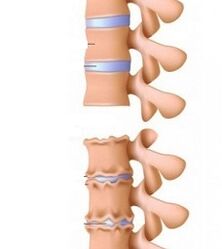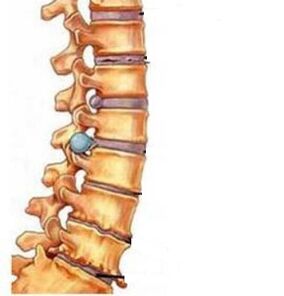
The osteochondrosis of the cervical region is a disease associated with a violation of metabolic processes, namely, the accumulation of salts in the blood and lymph, which leads to the pathological transformation of the structure of intervertebral discs, vertebrae and joints between vertebrae.The loss of elasticity cartilage tissue contributes to the displacement of the vertebrae, pinches of arteries and other distribution changes.
Due to the deformation of the joints, the height of the intervertebral discs decreases.It should be noted that in the cervical region the vertebrae are closer to each other than in other parts of the spine and, therefore, the discs are in a healthy state.
Osteophytes (bone growth) are formed on the sides of the vertebrae, which irritate the muscles, causing their tension.Osteophytes also squeeze the roots of the spinal nerve, the vertebral artery and the small blood vessels, of which brain cells do not receive enough blood.The brain degrades and dies.
For the frequency of occurrence of osteochondrosis of the second place of the neck after the lumbar crossing.The first signs of the disease may appear in school age, after 25 years in one way or another, this ailment is observed in almost all.In women aged 45 to 65, additional symptoms appear: tingling in the hands area during sleep against the background of pain and numbness.
The reasons for the development of neck osteochondrosis
Hypodinamia: a sedentary and sedentary lifestyle, mainly leads to cervical osteochondrosis.As a general rule, they are suffered by people whose work implies a long stay in one position: working on the computer, office workers, drivers, etc.Osteochondrosis should be expected if a person has an incorrect posture or keeps the body in an abnormal position for a long time, for example, has a mobile phone or telephone with a shoulder.

The incorrect posture on the computer leads to cervical osteochondrosis!
Excessive back and neck stress causes unusual physical activity for the body, for example, raising weights.The same effect is obtained with physical exercises that perform incorrectly.
The degeneration and dystrophy of the cervical region are due to constant nerve tension and stress, prolonged or temporary hypothermia of the body, unbalanced and scarce nutrition, infections.
The highest risk group belongs to people with a hereditary predisposition to osteochondrosis, with defects in the development of the spine, with a traumatic column or a back in general.The danger is the chronic diseases of the musculoskeletal system (rheumatism, scoliosis, systemic lupus erythematosus).The disease is favored by hormonal imbalance, overweight, flat feet, progressive discos.
The main symptoms of cervical osteochondrosis and the factors that cause them
The key symptom of osteochondrosis is pain in the occipital segment of the neck.If the nerve roots are affected, the pain extends to the shoulders, the forearms.With muscles spasm and deteriorated blood circulation, pain is felt in the ears, eyes, teeth, forehead.You can give in the shoulder blades, the chest, the gallbladder, the lower back.Painful sensations increase even with minimal loads, long situations, inclinations or turns of the head.The pain basically manifests after sleep and disappears if you develop muscles.Frequent departments occur: acute pain, along with muscle hardening and movement difficulties.

Numbness of arms and legs, burns and tingling is produced.The damaged roots with the nerves of the engine weakens the strength of the muscles of the extremities.Blood pressure can increase, get the heart.
The department of Cervical with sophisticated intervertebral discs, osteophytes in the vertebrae and the intervertebral joints affected crispy and abdominal if it throws it abruptly or turns their heads.
Tense arteries and blood supply worsened to the occipital fraction of the brain and cerebellum lead to neurotic disorders, which manifests in the form of irritability, anxiety, variability of mood, resentment and insomnia.There are outbreaks of anger, anorexia nervosa, fear, yearning.
For the same reason, the tongue and fingertips are numb, a voice of voice, hearing and vision decreases, its whispers in the ears, darkening in the eyes, fainting occurs.Almost always, especially in women, continuous, even stronger headaches are observed, if you turn sharply.
The affected vestibular device leads to disorientation in space, deteriorated coordination, dizziness and nausea and vomiting associated with these phenomena.
Stages of Development of Neck Osteochondrosis
Cervical osteochondrosis develops stately, each of the stages has its own clinical image.
In the first stage (preclinical), the muscles are slightly tense, the pain is weak, turning or bowing your head, it can increase.The rapid fatigue of the spinal and lumbar muscles is characteristic.At this stage, the disease is without medications.

The second stage occurs with a decrease in the height of the intervertebral and the pinch of nerve endings.In addition to the neck, shoulder and hand hurt.Fast fatigue, headache, distraction appears, work is difficult and performance is reduced.
The third stage marks the formation of intervertebral discs.Then, the muscles of the hands are weakened and numb, the constant pain gives to the arm or shoulder.The general weakness is accompanied by dizziness.
In the fourth stage, the vertebral artery is affected, the destroyed intervertebral disc is replaced by connective tissue.The coordination is disturbed, the severe dizziness and the noise in the ears are worried.
Symptoms of cervical osteochondrosis by type and vertebrae affected
Several types of cervical osteochondrosis are distinguished.
- Syndrome- Due to the pinch of nerve endings, the pain of high intensity, in addition to the neck, covers the shoulder, the forearm, feels in the shoulder blade and the lower back.
- Vail artery syndrome- It is distinguished by a pulsating headache on the back of the head or temple.
- Irritant syndrome - Reflection- Burning pain in the neck and neck gives to the chest and shoulder, turning the head, cough, in a dream that intensifies.
- Cardial syndromeIt occurs due to the damage to the spine of the diaphragmatic nerve or the large thoracic muscle.Pressing pain appear in the heart of the heart, they last several hours, when they move or breathe deeply, they intensify.
The defeat of different cervical vertebrae is manifested by its symptoms.
A surprising cervical vertebra (CI-II) of first and second cause pain in the neck and crown.The nerve root click (C3) leads to neck numbness, the sensitivity of the tongue decreases, speech is altered.If the spine of C4 is affected, the clavicle or shoulder is numb, the breathing is disturbed, the pain appears in the heart.The distribution of the vertebra of the 5th department has a violation of the sensitivity of the arms and legs and the pain in the shoulder.The compression of the roots of C6 and C7 is accompanied by pain in the neck, the forearm, the blade, the lower part of the back and back in general, the weakening of the sensitivity of the hands and fingers.The affected nerve root of C8 causes pain in the neck, back, elbow and lower limbs.Little fingers are numb in their hands, skin sensitivity decreases to zero.Due to the weakening of blood flow, legs and hands become cyanotic.
Cervical osteochondrosis diagnosis
The diagnosis of neck osteochondrosis begins with the collection of information on the lifestyle of a person and their work, the analysis of complaints and symptoms, it must also be discovered if this ailment was for family members.
Then, an external examination of the back and neck is carried out in different positions, which allows you to see if there are posture violations.The palpation of painful areas reveals the degree of pain and tension of the muscles and vertebrae.
The main role in the diagnosis is performed by instrumental research methods.
The longest instrumental method: X -Ray allows you to identify the general condition of vertebrae and vertebrates, but in the posterior stages of the disease it is ineffective.
Computed tomography has much better diagnostic capabilities, but this method does not allow a complete idea of the presence and size of intervertebral hernias.It is not clear if there is a compression of the spinal cord hernia.
The greatest efficiency is shown by magnetic resonance images (MRI).Not only bone formations are trace perfectly, but also other important structural elements of the spine: intervertebral discs, hernias, their parameters and how they develop.It is clear in what condition are soft fabrics.The ultrasound duplex scan of the vertebral vessels allows you to get an idea of its structure, permeability for blood flow and its speed, violations and abnormalities of the walls.
After establishing damaged intervertebral discs and the degree of their violation, you can prescribe proper treatment.Otherwise, not only the osteochondrosis will progress, but different complications are possible.
Complications for cervical osteochondrosis
Complications for cervical osteochondrosis arise due to the effect on:
- discs, nerves, nerve endings, plexus (neurological diseases);
- spinal cord;
- brain.
Nervous endings and blood vessels in the slightest disturbance are compressed, which, in turn, interrupts brain circulation, causes a series of disorders and diseases: migraine, hypertension, cardiac disability, problems with hearing, vision and coordination of attention arise.
The careless cervical osteochondrosis is loaded with the development of the vertebral artery syndrome, cerebral ischemia, spinal stroke and other mortal pathologies.Growth in the vertebrae (radicleopathy) leads to a complete or partial loss of sensitivity and mobility of the body.Tightening the spinal cord causes a fatal result.
Treatment of spine osteochondrosis
With degenerative lesions of the intervertebral discs, I use different treatment methods according to the symptoms.
Pharmacological treatment of cervical osteochondrosis
A specialist in osteochondrosis is a neuropathologist, a specialist directly in the spine is a vertebrologist.
Pharmacological treatment aims to eliminate pain, relieve inflammation, improve blood circulation, support the body as a whole.
The most disturbing syndrome: severe pain, sometimes unbearable, can be eliminated using non -steroidal anti -inflammatory medications (NSAIDs).The same drugs relieve aseptic inflammation and swelling of the roots of the damaged nerves.If the pain is weak, it is enough to take an analgesic.
You should know that most NSAIDs negatively affect the mucous membrane of the stomach, so it is not recommended to take them for a long time.
Anesthetize and simultaneously heat the affected areas can be ointments and gels.A pepper patch can be applied to the pain point, but its effect is limited to heating in the inflamed area.
Herbal diuretics and infusions are adequate to combat edema.
In the treatment of cervical osteochondrosis, vitamins B (B1, B6, B12) are certainly used.The vitamins of this group improve metabolic processes in nerve tissue.Effective oral tablets and solutions for intramuscular administration are effective, but injection administration is painful and can have complications.
The most important therapeutic task is the restoration of cartilage on the intervertebral disc.It is resolved using condoprotectors.It should be taken into account that all these drugs are biologically active additives with vague effectiveness.
The characteristics of the pathology require the use of medicines that improve blood properties, blood flow to the brain and nutrition of damaged nerve roots.
Muscle cramps can be eliminated by resorting to muscle relaxants.
Medications introduced into the body through intramuscular injection affect nerve endings faster.The blocks are carried out directly in the affected area, which quickly provides the required effect.
The duration of taking certain medications depends on the stage of osteochondrosis, the complaints of the patient and their related diseases.
Physiotherapeutic procedures

The treatment of cervical osteochondrosis without fail includes physiotherapeutic procedures.
Under the influence of electric current (electrophoresis), the medicine immediately enters the site of destruction.
The effect of anesthesia ultrasound, relieves inflammation, improves metabolic processes.Magnetotherapy relieves tissue edema and, therefore, reduces pain.Laser therapy has an anti -inflammatory effect and improves blood circulation.
To improve blood supply to the brain, the massage of the cervical zone is very useful.A special place in the treatment of cervical osteochondrosis is occupied by therapeutic exercises, especially if the limb numbness is observed.The patient's condition improves by improving blood circulation and reducing muscle stress.In the acute phase of the disease, gymnastics is not recommended, it must be done during recovery.
If conservative treatment does not give a positive result in 6 months, pain does not happen and damaged nerve roots are not restored, or manifested myelopathy, it can resort to surgical intervention.
With the root cause not eliminated from the osteochondrosis of the cervical region, and this is in most cases a sedentary and sedentary lifestyle, the pharmacological treatment will have a short -term effect.For irrevocable recovery, regular physical activity and nutrition are needed that do not contribute to the development of the disease.
Treatment of cervical osteochondrosis with popular methods
For the treatment of cervical osteochondrosis, products of plant and animal origin are used.They can be taken inside and apply outside.

For internal use, you can prepare a celery infusion, a 4-5 g of plants bay with a liter of boiling water and insisting for 2-4 hours.
The compress can be prepared from:
- Honey (1-2 teaspoons) and mom;Hot, put on a hot wool fabric and adhere to the affected area of the spine at night;
- foolishness;Grill the root in a grater, heat a little, wrap a gauze to apply to a painful point and tie it with a warm cloth to keep heat;
- burdock(Rinse the leaves with hot water, apply in a painful place and wrap with bandage when the leaves dry, replace with new ones).
To rub, you can use chamomile and oil (preferably olive), although sunflower is also suitable.30 g of flowers and 0.5 liters of oil over low heat to boil, insist 2 days, tighten and apply to the painful areas.For the chamomile, you can add Mosto de San Juan, Calandula, Celandine.
For the same purposes, you can prepare a lion tooth decoction, birch sprouts, mint, coriander leaves (combine the mixture with boiling water pronounced in a proportion of 1: 1, insist an hour, after rubbing, apply a heating bandage).A means of rubbing the calendula (50 g of flowers pours 0.5 liters of vodka, insist 2 weeks).
To get rid of the symptoms of osteochondrosis, leeches: Hirudotherapy has been used for a long time.In the early stages, 6 sessions are enough.But leeches can cause allergies and then, of course, the treatment ceases.
Popular remedies show effectiveness only in the initial stage of the disease, if the disease progresses, the basis of treatment should be pharmacological methods.
Prevention of the osteochondrosis of the cervical column
The main preventive measure of this disease is physical activity (including walks, swimming) and gymnastics (aerobic, yoga), but cannot increase excessive gravity.Cultureism can cause the protuberance of the cervical album.Support at the right level is full of this measure.When sitting, you must monitor the posture, after each hour take five minutes breaks, knead the neck every 2 hours.But acute head movements should be avoided.If you regularly massage, it will be possible to avoid the development of excessive muscle tension.

Food should be rich in vitamins, minerals (calcium, magnesium) and other beneficial substances.Gachas, eggs, legumes, mushrooms, low fat (beef, chicken, rabbit), shellfish (fish, crabs, oysters, lobsters, mussels), dairy products (milk, cabin hunt), fresh fruits (tail (coil, coil, eggplant, eggplant, eggplant, eggplant, eggplant, eggplant, bow, bow, bowArquee, Arquee, Arquee, Arquee, Arquee the arch.
If neck osteochondrosis is accompanied by atherosclerosis, it is necessary to limit the use of products that contain cholesterol: animal fats, fatty meat, fatty dairy products.Limited consumption products also include flour, sugar, salt products.
Alcohol is detrimental to that, falling in the blood, destroys the cells, which worsens the already poor blood circulation.Smoking also falls under the ban.
To protect osteochondrosis, stress should be avoided.A healthy dream is made to prevent the development of the disease.You should sleep on a solid mattress and a low pillow, the neck should not bend more than 15 °.
The hot shower, a sauna and a bathroom help to remove the spasms from the neck.
If there is a predisposition to osteochondrosis, the doctor should be shown occasionally.



















